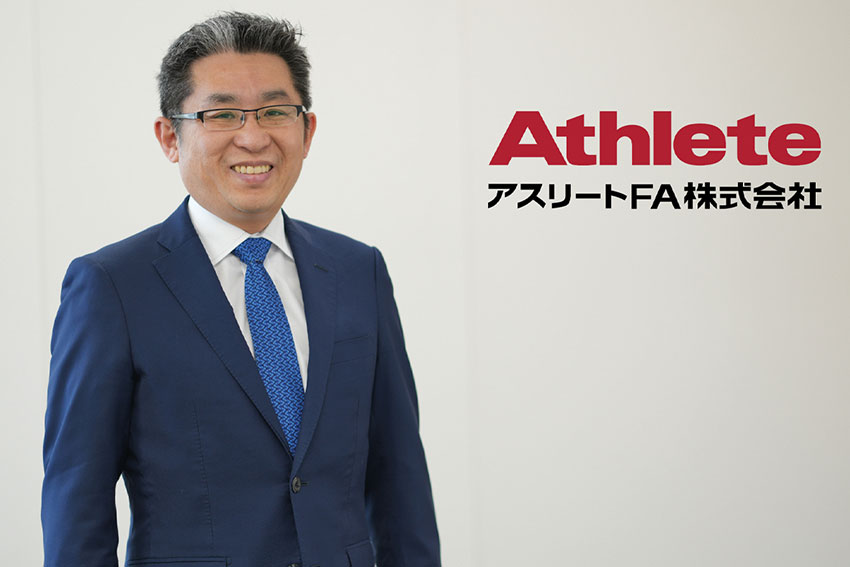As global supply chains diversify and automation technology advances, Japanese manufacturers leverage their superior technology and high standards to seize new opportunities in emerging and established markets. In an exclusive interview, Athlete FA Corporation discuss the challenges and strategies shaping Japan's manufacturing future.

Right now is a pivotal time for Japanese manufacturers. Policies like the US Inflation Reduction Act are forcing corporations to diversify their supply chains for reliability and to reduce country risks, particularly with nations such as China. Japan is known for its reliability, advanced technology, and a weak yen, making it a cost-effective option for the time being. This means that Japanese firms have an opportunity to expand their existing global market shares. Do you agree with this sentiment, and in your opinion, what do you believe to be the advantages of Japanese companies in this current macroeconomic environment?
There is no doubt that we are on the losing side compared to China and other emerging countries in terms of price. Currently, we do have a market in China; however, there are companies selling similar products at a cheaper price, and these companies are becoming more numerous.
We have superb technology compared to other local manufacturers, so even though they may have an advantage price-wise, we can offer better value, including performance and quality. Although we cannot compete on price, we can offer products with high value, better quality, and greater accuracy. Customers who want such products will choose our company every time, and those are the customers we are appealing to.
I think our greatest assets are our superior technology and high Japanese standards. The area we are in right now is small and surrounded by mountains, but it is the heart of Japanese manufacturing for high-precision tools and equipment. Many of the local companies here have business dealings with global leading companies thanks to our technology and quality.
Japan is the world’s oldest country, with a rapidly shrinking population due to low birth rates. Experts predict that by 2050, Japan’s population will dip below 100 million, with around 33% of people over the age of 65. This will result in issues such as a labor crisis, a shrinking domestic market, and questions regarding skill inheritance. On the other hand, it presents opportunities such as increased production for automation technologies. What specific challenges and opportunities has your company seen as a result of this demographic shift, and how have you been reacting to them?
Regarding this issue, we are concerned with the declining availability of people to work in the manufacturing sector, especially with the steadily increasing average age of people here in Japan. We are struggling with the recruitment of not only new graduates but also mid-career personnel. This is an area where we need to put more effort.
As you pointed out, in the coming years, the number of working-age people will decrease, and automation technology will have to advance more to compensate. This will increase our dependence on machines and tools, causing demand to grow and opportunities to increase.
There is a rise these days in PC-manipulated technologies, including generative AI and digitalization. With these technologies becoming more prevalent, the idea of efficiency is often discussed. With all this discussion, we believe that automation needs will increase.
Your company caters to a wide range of industries, including semiconductors, electronics, optics and imaging, and even the automotive industry. Your products are essential to cutting-edge technologies such as 5G, data centers, and high-performance computers. Among these wide ranges of industries, which do you believe has the most potential for future growth from a business perspective?
I think advanced computing and data centers are two areas that are going to grow in the coming years. Of course, semiconductors are another industry that is constantly evolving and advancing, and this is because, in our daily lives, we need more memory and faster data speeds. As the amount of data we collect increases, so too must the processing capacities of chips. However, right now, input costs are quite high, and this is particularly an issue for the domestic market. We do have a market overseas to compensate, and that is an area expected to grow.
Data centers, servers, and cloud computing are all booming right now, but we have yet to reach the ceiling of their growth. These three industries are all expected to experience significant growth going forward. There is so much data that needs processing, more than ever before in history. Many technologies will emerge in the years to come to handle the data needs of the next generation.
To cater to the markets of the future, you need very precise machinery. Among these machines, we find your BM-2150SI, a versatile micro-ball mounter and inspection system for a wide range of products from strips to panel-size substrates. How does your BM-2150SI ensure accurate alignment of substrates during the micro-ball mounting process, and how does this product handle substrates of different sizes and shapes within its specific range?
Marks on the surface of the substrate are recognized by image processing and used as a reference for positioning. For large substrates, multiple marks can be recognized to eliminate disturbance factors such as stretching and deformation of the substrate as much as possible, enabling accurate alignment of the substrate position. In addition, for accurate positioning of the relative positions of the stencil and substrate used in the ball mounting process, a system of dual-view cameras (top and bottom) is used to simultaneously recognize marks on both the stencil and substrate, enabling precise alignment with fewer errors. These recognition camera systems and a fully closed, precisely controlled XY stage enable precise alignment of substrates.
Regarding sizes and shapes, there are certain specifications for substrate panels. We use equipment parameter settings to switch and comply with the requirements of each product. For large panels that are over-specification, we use a jig change kit to meet the required specs.
In addition to ball-mounting equipment, we also provide bonding machinery. A machine that stood out during our research was the CB-3000, a mass-production flip-chip (FC) bonder for controlled collapse chip connection (C4) processes. Can you explain how the calibration function of the CB-3000 enhances the accuracy of bonding processes?
For automation equipment, the environment makes a big impact. The time of installation or the clean-room environment makes a big difference. When we turn on the machine, a certain level of swelling occurs, which can affect performance. We want our machines to provide the best performance possible, so we set it up and then run it throughout the first day. Errors will occur eventually, so the machine has a built-in mechanism to adjust itself and fine-tune the initial settings. Errors are therefore fixed, making it possible for the machine to provide the best performance.
The CB-3000 is a mass-production FC bonder. Despite its usage in mass production, how do you ensure high-quality standards?
Needless to say, at each step of the process, we make sure everything meets the necessary standards and criteria. Unit by unit, we review, validate, and check to eventually reach the best possible speed, accuracy, and precision.
Our primary focus lies in showcasing our high accuracy and precision. Speed, while still important, is an additional value that complements our core functionality. We have a management system for the entire process using check sheets. At every stage, we ensure high quality. Of course, differences are created, but we factor that in to minimize the impact. Everything is detailed, so we ensure everything is done just right at each stage.
At the end of last year, you released your AB-1000 wafer die-bonder. This machine supports the supply of eight to twelve-inch wafers with a maximum die size of 2.5 millimeters on the board side and a chip size of 0.15 millimeters to 1 millimeter. How do you explain the significance of supporting both eight and twelve-inch wafers? How does this product manage the differences between the sizes effectively?
We provide both eight and twelve-inch products to have a better lineup for our users. Twelve inches is the maximum size, so if we are capable of producing that size, eight inches is not a problem. The AB-1000 is for smaller size chips, and there are certain limitations. However, within the specifications, there aren’t any problems.
We saw that your firm has experienced rapid growth in revenue, with sales increasing at an annual rate of 50% since 2020. Despite temporary setbacks in 2023, your company is estimating a restoration of sales up to 2025 and onwards. Given this impressive growth trajectory, what strategies does your company plan to implement to sustain and further accelerate this revenue expansion?
Yes, over the past three years, demand has surged due to COVID-19. The pandemic accelerated the requirements for more semiconductors, servers, and PCs. Performance actually doubled, which was a big surprise for us. However, if sales double, it means our work doubles. We didn’t have the availability of man-hours to sustain such high demand, so we had to use OEMs and hire contract workers to fill the gaps.
Right now, the semiconductor market is cooling down a bit, but we are preparing for the years ahead. One thing we are focusing on is improving products and capabilities. Basically, we are looking to provide for the requirements of even smaller parts.
At the moment, other companies have the capabilities to provide better products, but we are boasting our technology that can provide high performance throughout our equipment. We are putting a lot of effort into our R&D so that we can create at an even sub-micron level. Such products, once developed, will continue the growth in our sales.
In other interviews with industry players, we have often heard that partnerships are key to unlocking new markets or developing new products. Could you tell us, in terms of new partnerships, what kind of collaborators you are seeking? Are you looking just for domestic partners, or are you also looking to partner with international firms?
Right now, we aren’t looking for overseas partners. Currently, 20% of our customers are domestic, and 80% are overseas. This means that our business dealings overseas are growing. We do work with distributors, so those are a form of partnership that we want to expand overseas.
Which regions or countries outside of Japan do you believe have the most potential for the future growth of your firm?
Overseas, we work mainly in Taiwan, China, and South Korea. However, we are looking towards expansion in Southeast Asia. Additionally, we are looking optimistically towards emerging countries like India, but for now, those countries remain a mystery to us. Experts are predicting major growth in these emerging nations, which means there will be demand there sooner rather than later. Honestly, we are looking to expand in any potential country.
The US and European markets are strong markets when it comes to the semiconductor industry. Could you elaborate on what role you believe these markets will play in the future of your firm?
There are some efforts already in place to target Western countries, including the US and Europe. The US is positioned high in our strategy, but they have large companies doing mass production in Taiwan and Southeast Asian countries. This means that we are indirectly working with those companies, especially regarding developing advanced technologies. Also, our company has a limited number of people, so by working with distributors, we hope to expand the market in those countries as well.
Imagine that we come back in four years and have this interview all over again. What goals or dreams would you like to achieve by the time we come back for that new interview?
We have 100 people working for this company, and it has been five years since I assumed the position of president. Perhaps a major goal I have is to make this company one that can provide high-precision and high-quality products to the global market.

0 COMMENTS